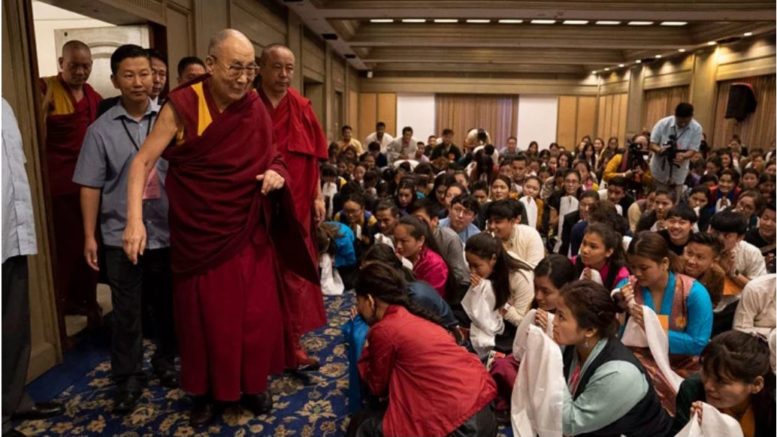Mangaluru, Karnataka, India – After arriving in the port city of Mangaluru yesterday, this morning, His Holiness the Dalai Lama’s first meeting was with a group of about 250 young Tibetans studying and training here. His Holiness recalled hearing about claims that Tibet had long been part of China made in an exhibition in Beijing in the ‘70s. These included Songtsen Gampo’s marriage to a Chinese princess and Genghis Khan’s giving Drogön Chögyal Phagpa control over Tibet. In the context of the Great Wall of China that attracts so many tourists today, according to which land on one side was China and on the other was not, these claims have no weight. His Holiness remarked that he has also been told there are no historical documents from the time of the Tang Dynasty that refer to Tibet as part of China.
“The Chinese princess who married King Songtsen Gampo,” he observed, “brought an important image of the Buddha with her as a gift. When I visited Xi’an, a former capital of China, I was shown the empty niche where it used to sit. Relations between Tibet and China were good. Nevertheless, Songtsen Gampo chose not to emulate the Chinese style of writing and instead had a Tibetan alphabet modelled on the Indian Devanagari script.
“Later, although King Trisong Detsen’s mother was Chinese, he again opted to invite first Shantarakshita and then Guru Padmasambhava to Tibet from India. These three, the King, Abbot and Adept, established Buddhism in Tibet. There were many Chinese monks in Tibet, whose focus was on meditation rather than study, but it seems that the image of the Buddha inspired the kings to look to India as the origin of Buddhist teaching.
“Shantarakshita was very learned and the approach he introduced of study, reflection and meditation we still uphold today. We learn on the basis of reason not just faith. Rather than merely accepting what we’re told, we investigate.
“The Buddha’s first round of teachings, which dealt with the Four Noble Truths were given openly in Varanasi. The second round, given in Rajgir, included the ‘Heart Sutra’ that you probably all know—and is founded on reasoning. I once asked a group of Thai scholars who uphold the Pali Tradition whether they explained the Four Noble Truths on the basis of scriptural authority or reason and they told me that they cited the authority of the scriptures. I reflected how fortunate we are to have the works of Dignaga and Dharmakirti that elucidate the use of logic and reason.”
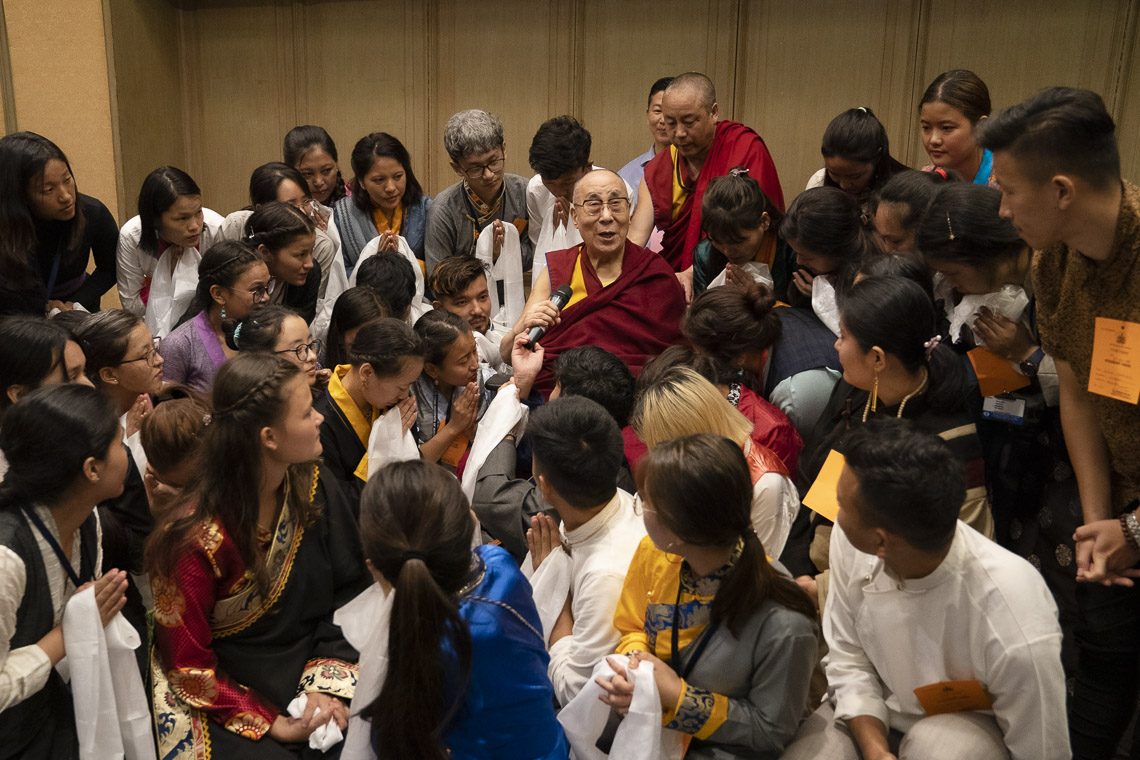
His Holiness the Dalai Lama speaking about his improved health during the photo session with Tibetan college students in Mangaluru, Karnataka, India on August 30, 2019. Photo/Tenzin Choejor/OHHDL
Despite having highlighted this difference in their approach to understanding between the Pali and Sanskrit traditions, His Holiness went on to emphasise that they both have the Vinaya, monastic discipline in common. He told the story of two Burmese monks coming to see him at a gathering of the World Parliament of Religions in Melbourne, Australia. They expressed surprise to find that Tibetan monks observe the Vinaya precepts just as they do.
His Holiness explained to the Tibetan students that some years ago he launched a project to reclassify the contents of the Kangyur and Tengyur under headings of science, philosophy and religion, and to compile books accordingly. Scholars have completed the volumes concerning Buddhist science, which mostly deals with the study of the mind. They have been translated into Chinese, Russian, Hindi, English, Japanese, Mongolian and so forth. He mentioned that he has been informed that people working in universities in China can access these materials even though they are not available to the general public.
Referring to the way our habitual self-centredness makes us suspicious of others, His Holiness noted that we can counter this by cultivating bodhichitta, the altruistic awakening mind. Another problem we have is seeing things as having a solid independent existence. We can counter this by investigating Nagarjuna’s instruction that things do not exist the way they appear.
“If you have a sense of bodhichitta, you’ll be happy,” he told the young Tibetans. “Remember that Tibet is the land of Avalokiteshvara; he is the patron deity of the Land of Snows. China has tried to eliminate Tibetan tradition and failed. The Chinese depend on the power of the gun, but we depend on the power of truth. In China things are changing and the Party is afraid of losing control. Our strength lies not in seeking independence, but in keeping our cultural traditions alive.”
The students gathered around His Holiness to have their photographs taken with him. Shortly afterwards he met with local Indian political representatives, to whom he extolled the qualities of ancient Indian knowledge, asserting that the world urgently needs ‘ahimsa’ and ‘karuna’—non-violence and compassion.
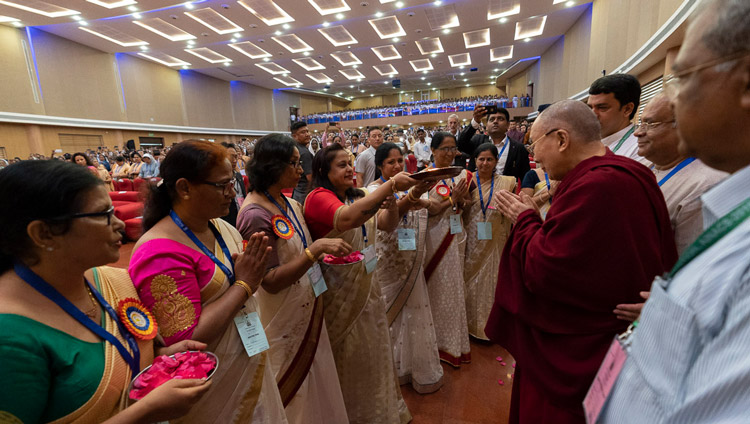
His Holiness the Dalai Lama receiving a traditional welcome on his arrival at the Father Muller Convention Centre to attend the 52nd National Convention of the All India Association of Catholic Schools in Mangaluru, Karnataka, India on August 30, 2019. Photo/Tenzin Choejor/OHHDL
A short drive across Mangaluru brought His Holiness to the Father Muller Convention Centre where Dr. Bro. Thomas Thanickal and Fr. Jimmy James welcomed him to the 52nd National Convention of the All India Association of Catholic Schools (AINACS). In the lobby Christian nuns offered him ‘aarti’ and he teased them in return by scattering rose petals over them. A brass band played a welcoming fanfare. Inside the auditorium he lit a lamp to inaugurate the meeting and took his seat on the stage. The brass band played ‘When the Saints Go Marching in’ and were followed by a choir of nuns and a group of students who sang songs of welcome.
Sister Molly Cherian, Principal of the Sacred Heart School, Sidhpur in Dharamsala, introduced His Holiness to the gathering. She quoted him as saying, “True joy is in serving others”. She noted his commitment to promoting human values and encouraging inter-religious harmony. She ended with a request to the two Catholic priests to honour him with the gift of a shawl and a bouquet of flowers.
Invited to address the 1000 strong audience that included 150 students from the Himalayan Region as well as Catholic educationists, His Holiness greeted them as respected spiritual brothers and sisters and younger brothers and sisters.
“I’m very happy to be with you today,” he continued. “When I meet older people I wonder which of us will go first, but when I meet younger people, I feel younger myself. In fact, I belong to the 20th century generation, while many of you belong to the 21st century. What’s past is past, we can’t change it, but we can learn from it. What is clear is that the future of humanity is in our hands. Look at the world today and the problems we face. There is the growing gap between rich and poor, and even in wealthier countries people are mentally unsettled.
“Scientists observe that basic human nature is compassionate, which is understandable since we are social creatures. Individuals’ survival and simple happiness depends on the community. If we watch young children, they don’t care about differences of faith or nationality, they respond to each other in an open human way. After our birth, we survive due to our mother’s affection, which gives us a sense of security that lasts throughout our lives.
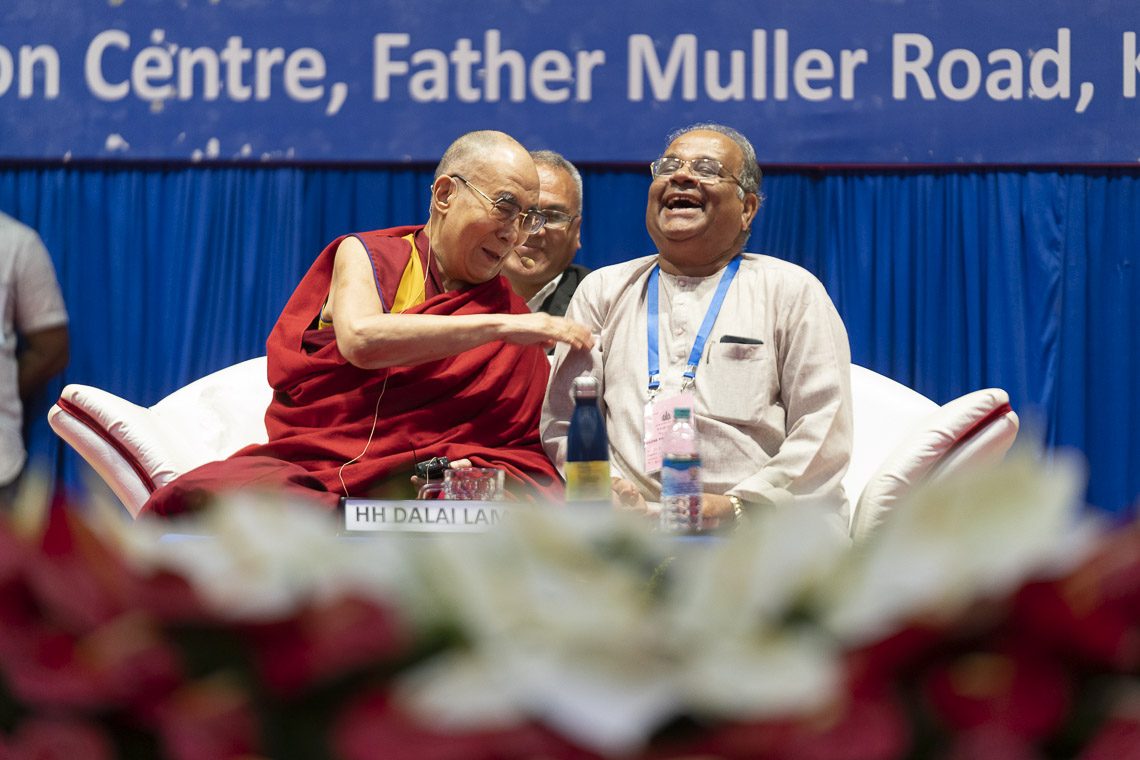
His Holiness the Dalai Lama enjoys a moment of laughter at the session of the 52nd National Convention of the All India Association of Catholic Schools in Mangaluru, Karnataka, India on August 30, 2019. Photo/Tenzin Choejor/OHHDL
“The future of people here in Mangaluru depends on the rest of India. India’s future depends on the rest of Asia. The reality is that all seven billion human beings alive today are one community. If we appreciated that there’d be no room for war and killing each other. However, these days there’s too much stress on ‘us’ and ‘them’; that’s a source of conflict. Because of this, many of the problems we face are our own creation. We neglect the basic human qualities of kindness and compassion. Education focused on material values gives rise to this.
“It’s only after they start going to school that children learn to discriminate about faith, caste and nationality, which again leads to a sense of ‘us’ and ‘them’. Education shouldn’t only be about cultivating our brains; we need warm-heartedness too.
“All our major religions convey a message of love and compassion. They adopt different philosophical approaches and different ways of life, but they all encourage love, tolerance and contentment.
“As a human being I am committed to trying to share with others that we are social creatures, because of which, whether we are religious believers or not, we need a sense of concern for others’ well-being. I’m also committed to promoting harmony among religions. You Christian brothers and sisters believe in God the creator—that’s wonderful. If you see all human beings as children of God, how can you do them harm? Those of us who belong to non-theistic traditions, like Jains, Buddhists and some Samkhyas, believe instead in the power of our own actions. If you do good, happiness results.
“Whatever our personal belief, India is an example that harmony among religions is possible. All the major religions flourish here. They respect each other and learn from each other. Many years ago in Thailand, I met the Sangharaja, the leader of the monastic community. I mentioned to him that our Christian brothers and sisters were widely active in promoting health and education. I told him I felt we Buddhists should follow this example. He replied that it’s more proper for Buddhist monks to remain in isolation.”
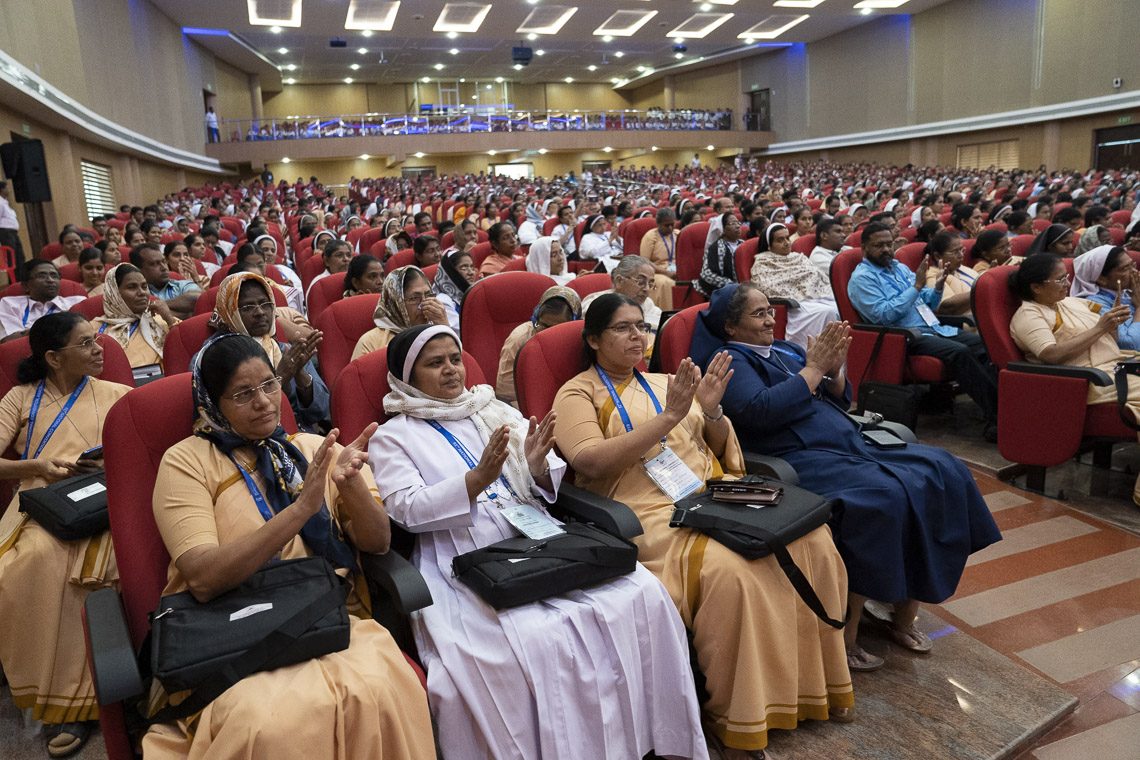
A view of the hall at the Father Muller Convention Centre as His Holiness the Dalai Lama speaks at the 52nd National Convention of the All India Association of Catholic Schools in Mangaluru, Karnataka, India on August 30, 2019. Photo/Tenzin Choejor/OHHDL
His Holiness ended his talk with the observation that just as Mahatma Gandhi had set an example of the effectiveness of ‘ahimsa’, non-violence, in the 20th century, today, India could again serve humanity by demonstrating how to achieve peace of mind. He mentioned the ancient practices for cultivating tranquillity and insight, ‘shamatha’ and ‘vipashyana’, as proven paths for transforming the mind. He added that it is individuals with healthy minds who constitute a healthy society.
Among questions from the audience were two about vegetarianism. His Holiness felt that the prospect of vegetarian tigers was unlikely, but that human beings could be encouraged to understand that a vegetarian diet is good for our health. He observed that those who kill in the name of religion cannot be counted as sincere followers of their faith. He reiterated that the primary purpose of religion is to develop loving-kindness in its adherents.
Reminded of his friendship with Bishop Desmond Tutu, he remarked that Tutu calls him a mischievous Dalai Lama, while he in turn refers to Tutu as a mischievous bishop. He recalled with a chuckle Tutu’s once pointing out to him that as a Christian he was ready to go to heaven, but the Dalai Lama will go somewhere else.
Challenged to say whether Tibet will be free in his lifetime, His Holiness asserted that China’s authoritarian regime will change. He noted that he is not seeking independence for Tibet, but admires the spirit of the European Union according to which old foes have promoted the common good over conflict.
A student whose father is Buddhist, but whose mother is Catholic wanted to know which is more important, compassion or truth. His Holiness told him that compassion is what’s important and that you don’t have to be Buddhist or Catholic to practise it. He stressed this again when he emphasised that practising compassion here and now—living a meaningful life—is what is most important.
After formal words of thanks and the presentation of a memento of the occasion to His Holiness, he came to the front of the stage to wave goodbye. Many in the audience waved back. Before returning to his hotel, His Holiness shared lunch with members of the AINACS organization.
Tomorrow, he will travel to Delhi on his way back to Dharamsala.

His Holiness the Dalia Lama answering a question from a member of the audience during his talk at the 52nd National Convention of the All India Association of Catholic Schools in Mangaluru, Karnataka, India on August 30, 2019. Photo/Tenzin Choejor/OHHDL

